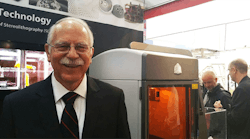When Chuck Hull invented stereolithography in the early 1980s, he had some ideas about what it might spawn, but he could have never imagined the scope of the current 3D-printing world. Now the CTO of 3D Systems, the company he founded in 1983, Hull is the benevolent father figure of a booming industry.
Chuck Hull invented stereolithography and in a makeshift lab back in the early 1980s, around the same time Carl Deckard invented selective last sintering and Scott Crump invented fused deposition modeling.
Hull was the first to apply for and ultimately be issued patents, though, the first of which he received in early 1986. Thirty years later, those early patents have entered into the public domain and opened the door for more development than ever.
Hull, who recently celebrated his 77th birthday and his 30th anniversary with 3D Systems, where he now works as the chief technology officer, discussed his thoughts on no longer really owning those first patents during a long conversation on the show floor at Hannover Messe in Germany.
He also addressed what might be in store for the additive manufacturing industry and how its history could help it continue moving forward.
Matt LaWell: Thirty years in now, what's new with 3D Systems?
Chuck Hull: We're expanding into some bigger systems, some titanium-based systems, and we just showed that at the St. Louis Additive Manufacturing Users Group Conference. The other thing we're talking about that's new is we have a video, a technology demonstration, of a product we haven't named yet. We're calling it Figure 4 because it's derived from our initial Figure 4 patent, and it's a new development of something I thought of over 30 years ago — new materials, new methods.
ML: Still building on those early patents.
CH: This kind of printer is anywhere from 20 to 50 times as fast as the currently typical stereolithography system. The other major advantage with the small material supply is that we don't worry so much about things like vat life. A large, typical stereolithography system, the material sits there and you want it to last a year, two years, three years before it might start to lose its holding ability. With a little, small vat, you're changing that several times a day. That lets our chemists not worry so much about traditional stability, and we can run more reactive chemistries and we can get more physical properties. We have the combination of new printer materials and high speeds, so our idea now is not to make a traditional printer.
ML: Who might put this to use in manufacturing? Is it designed to appeal and bring in new users?
CH: It really opens the door to anybody who makes plastic parts. This is not a new idea — everybody would like to make plastic parts with 3D-printing — so it's not like a mystery as to who would use this. Lots of people have talked with us about this, and they've talked with every other 3D-printing company. The question is, What do you do about it? Our answer is, You can just gang as many of these together as you need — these are not as expensive as a typical stereolithography system — and then automate that. The automation, with 3D-printing, you sort of get this wet part, and the automation here takes care of that, cleans it up and so from a factory point of view now you're just taking these parts and where do you go next with them?
ML: What could be in store for additive manufacturing, heck, not even in 2046, but just in, say, 2018?
CH: I always say, first disclaimer, I'm not much of a futurist. But certainly, the benefits are no tooling, customizable fasts, and so a lot of plastic parts will be automated and built with 3D-printing. It's another step toward digital manufacturing, and it fits right into the whole movement. In the future, people won't even think about it. It'll be the recognized way to manufacture plastic parts. The same with metal parts, except right now the provision is that those tend to be more specialized parts. Maybe they'll advance to the same level.
The trend we're on right now is more aerospace parts and medical parts, and of course the benefits in aerospace are that you can get what you want and you can build things in ways where you get the same performance but with a lot less weight. You take out all the metal that doesn't do anything and you can save at least half the weight, if not more. I could just see that really progressing. … There are still barriers. Right now, we're going through all the regulatory stuff, us and others. It's going well. I can see that happening. In medical, certainly, I think it's progressed to the point where more and more medical implants are used, and we have a facility in Belgium that's made a couple hundred thousand implants. That seems to be going well. The advantage, of course, is that they're customizable, and you can make them better. You can make them cheaper and better with additive, and the functionality is a lot better.










